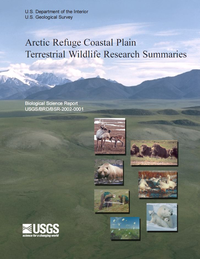Arctic Refuge coastal plain terrestrial wildlife research summaries
Links
- Document: Report (pdf)
- Chapters:
- Chapter 8 : Polar Bears
- Chapter 9 : Snow geese
- Chapter 5 : Forage quantity and quality
- Chapter 6 : Predators
- Chapter 1 : Introduction
- Chapter 2 : Land cover
- Chapter 3 : The porcupine caribou herd
- Chapter 4 : The central arctic caribou herd
- Chapter 7 : Muskoxen
- Download citation as: RIS | Dublin Core
Abstract
In 1980, when the U.S. Congress enacted the Alaska National Interest Lands Conservation Act (ANILCA), it also mandated a study of the coastal plain of the Arctic National Wildlife Refuge. Section 1002 of ANILCA stated that a comprehensive inventory of fish and wildlife resources would be conducted on 1.5 million acres of the Arctic Refuge coastal plain (1002 Area). Potential petroleum reserves in the 1002 Area were also to be evaluated from surface geological studies and seismic exploration surveys. Results of these studies and recommendations for future management of the Arctic Refuge coastal plain were to be prepared in a report to Congress.
In 1987, the Department of the Interior published the Arctic National Wildlife Refuge, Alaska, Coastal Plain Resource Assessment - Report and Recommendations to the Congress of the United States and Final Environmental Impact Statement. This report to Congress identified the potential for oil and gas production (updated* most recently by the U.S. Geological Survey in 2001), described the biological resources, and evaluated the potential adverse effects to fish and wildlife resources. The 1987 report analyzed the potential environmental consequences of five management alternatives for the coastal plain, ranging from wilderness designation to opening the entire area to lease for oil and gas developement. The report's summary recommended opening the 1002 Area to an orderly oil and gas leasing program, but cautioned that adverse effects to some wildlife populations were possible.
Congress did not act on this recommendation nor any other alternative for the 1002 Area, and scientists continued studies of key wildlife species and habitats on the coastal plain of the Arctic Refuge and surrounding areas. This report contains updated summaries of those scientific investigations of caribou, muskoxen, predators (grizzly bears, wolves, golden eagles), polar bears, snow geese, and their wildlife habitats.
Contributions to this report were made by scientists affiliated with the U.S. Geological Survey; U.S. Fish and Wildlife Service; Alaska Department of Fish and Game; University of Alaska-Fairbanks; Canadian Wildlife Service; Yukon Department of Renewable Resources; and the Northwest Territories Department of Resources, Wildlife, and Economic Development.
Sections of the report presenting new information on caribou and forage plants were peer-reviewed by three independent, non-affiliated scientists. The remaining sections summarize previously published peer-reviewed scientific papers and were reviewed by a single independent scientist. The U.S. Geological Survey and the U.S. Fish and Wildlife Service collaborated in the publication of this report.
Study Area
| Publication type | Report |
|---|---|
| Publication Subtype | Federal Government Series |
| Title | Arctic Refuge coastal plain terrestrial wildlife research summaries |
| Series title | Biological Science Report |
| Series number | 2002-0001 |
| Year Published | 2002 |
| Language | English |
| Publisher | U.S. Geological Survey |
| Publisher location | Reston, VA |
| Contributing office(s) | Alaska Science Center |
| Description | x, 75 p. |
| First page | 1 |
| Last page | 75 |
| Country | Canada, United States |
| State | Alaska, Northwest Territories, Yukon Territory |
| Other Geospatial | Arctic Refuge Coastal Plain, Arctic National Wildlife Refuge |
| Online Only (Y/N) | N |
| Additional Online Files (Y/N) | N |


